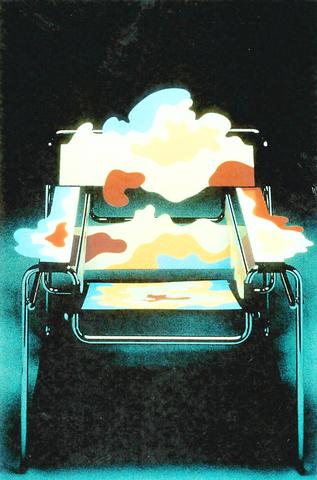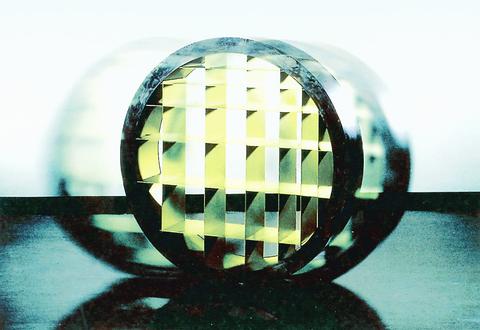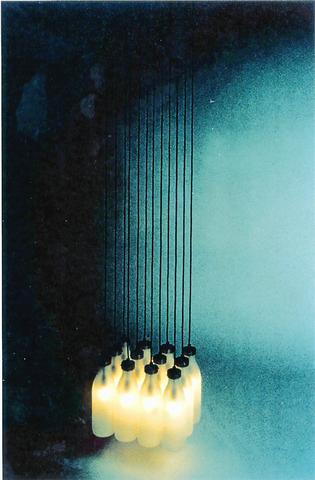After the German-American architect Ludwig Mies van der Rohe put forward the concept that "less is more," stark simplicity and rigidly geometrical structures dominated design and architecture in the second half of the 20th century. During the 1980s, however, some designers opted out of this trend, triggering lively discourse between followers of van der Rohe's dictum and supporters of deliberate ornamentation.
The philosophy of the breakaway designers is summed up by French designer and architect Philippe Starck, who said "I don't believe in `less is more.' I believe in `less and more.' We don't have to make a choice between the two, but to let them exist at the same time."

PHOTO: MENDINI
"Moins et Plus" (Less and More) at the Taipei Fine Arts Museum is an exhibition -- on loan from the French culture ministry's national foundation of contemporary art -- that emphasizes this variety in the realm of design between 1980 and 2000.

PHOTO: MENDINI
The museum has set up 11 areas to display the works of 11 prominent European designers, as well as areas to demonstrate the design concepts of unification, fragmentation, piling up and combination.
Of the 570 works on exhibit, Starck, famous for refurbishing the private apartments of the Elysee Palace in Paris for former French president Francois Mitterrand, is represented with more than 100 pieces.

PHOTO: MENDINI
His designs from the 1980s are defined by his keyword "objet-minimum" (object-minimum). Easy Light, a portable light tube in the most basic possible shape, devoid even of a visible switch, is one of his first "object-minimum" works. In the 1990s Starck's works followed his own concept of "anonymat plus" (anonymity more), which aimed to reconcile "more" and "less." A line of lamps named Miss Sissi, with their basic shape, rich texture and exquisite color, is a prime example from this period.
With furniture design in Taiwan still dominantly minimalist, viewers of this exhibition may find that what catches their eye most are the works by Italian designers, whose pieces are wonderfully playful and who integrate decorative arts into their designs.
Denis Santachiara's Doormat with Songbird on Stem, for example, can chirp greetings to incoming guests. A lamp, by the same artist, titled ltalian Nocturne ingeniously projects fence-jumping sheep on the wall. His thoughtful designs, which appeared in the Venice Biennale in 1980, stress the "softness" of objects.
Matali Crasset's works explore "less" in a unique way. A broomstick is used as a coat rack, while a clothes hanger holds a lamp shade, confounding ideas of functionality.
At a time when the line separating fashion and poster design from fine art has long vanished, and working with mixed media is becoming the leading trend, ingenious designs like Crasset's at this exhibition may remind you that even the stool you sit on can be art.
Art Notes:
What: Moins et plus (Less and more)
Where: Taipei Fine Arts Museum, 181 Chungshan N. Rd., Sec. 3, Taipei (台北市立美術館,中山北路3段181號)
When: Until Sept. 23

May 18 to May 24 Pastor Yang Hsu’s (楊煦) congregation was shocked upon seeing the land he chose to build his orphanage. It was surrounded by mountains on three sides, and the only way to access it was to cross a river by foot. The soil was poor due to runoff, and large rocks strewn across the plot prevented much from growing. In addition, there was no running water or electricity. But it was all Yang could afford. He and his Indigenous Atayal wife Lin Feng-ying (林鳳英) had already been caring for 24 orphans in their home, and they were in

President William Lai (賴清德) yesterday delivered an address marking the first anniversary of his presidency. In the speech, Lai affirmed Taiwan’s global role in technology, trade and security. He announced economic and national security initiatives, and emphasized democratic values and cross-party cooperation. The following is the full text of his speech: Yesterday, outside of Beida Elementary School in New Taipei City’s Sanxia District (三峽), there was a major traffic accident that, sadly, claimed several lives and resulted in multiple injuries. The Executive Yuan immediately formed a task force, and last night I personally visited the victims in hospital. Central government agencies and the

Australia’s ABC last week published a piece on the recall campaign. The article emphasized the divisions in Taiwanese society and blamed the recall for worsening them. It quotes a supporter of the Taiwan People’s Party (TPP) as saying “I’m 43 years old, born and raised here, and I’ve never seen the country this divided in my entire life.” Apparently, as an adult, she slept through the post-election violence in 2000 and 2004 by the Chinese Nationalist Party (KMT), the veiled coup threats by the military when Chen Shui-bian (陳水扁) became president, the 2006 Red Shirt protests against him ginned up by

As with most of northern Thailand’s Chinese Nationalist Party (KMT) settlements, the village of Arunothai was only given a Thai name once the Thai government began in the 1970s to assert control over the border region and initiate a decades-long process of political integration. The village’s original name, bestowed by its Yunnanese founders when they first settled the valley in the late 1960s, was a Chinese name, Dagudi (大谷地), which literally translates as “a place for threshing rice.” At that time, these village founders did not know how permanent their settlement would be. Most of Arunothai’s first generation were soldiers